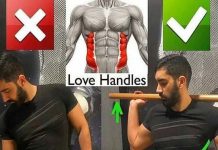🔥 5 HIT TOP SHOULDER EXERCISES
✅ If you’re reading this article, we assume that you don’t have to be convinced that big, strong shoulders are one of the trademarks of a great physique. You already know that. You just need to find out how to get there in the shortest time possible.
✅ So let’s cut to the chase. In this article we’ll help you design a highly efficient shoulder training program by providing you the best shoulder exercises that you can use for building both size and strength. You simply cannot go wrong with these mighty moves, so read carefully and get ready to pound some heavy iron.
🚨 1) Cable Front Raise
✅ Intro: The cable front raise is a brutally effective shoulder movement which allows you to isolate the anterior deltoid head while requiring minimal dynamic assistance from other muscles. While both dumbbells and cables offer the benefit of working the shoulders in a unilateral way that ensures equal resistance and reverses any muscle imbalances, the use of cables for the front raise brings another benefit to the table – continuous resistance throughout the movement. Besides working the anterior delts, the exercise also requires the activation of a number of stabilizing muscles such as the trapezius, erector spinae, biceps, rotator cuff and serratus anterior.
✅ Targeted muscles: Anterior and medial deltoids.

[wp_ad_camp_3]
✅ How to: Select the weight you would like to use on a low pulley machine and grab the single hand cable attachment with your left hand. Stand in a shoulder-width stance and place the non-working hand on your hip for better balance. Your torso should be stationary all throughout the movement, while the knees should be bent slightly. With the hand cable attachment in front of you at arm length, powerfully raise the cable up and out in front of you until your upper arm becomes parallel with the working shoulder, maintaining a flat back. To ensure maximum safety and avoid injuries such as shoulder impingement, slightly turn your thumbs in the air as you approach the high point of the movement, instead of keeping your palms facing down. Exhale as you execute this portion of the movement and pause for a second at the top to squeeze the working muscles. As you inhale, lower the arm back down to the starting position and repeat for the number of desired repetitions, then switch arms and perform the exercise with the right arm.
🚨 2) Dumbbell Lateral Raise
[wp_ad_camp_4]
✅ Intro: Lateral raises work great for building your shoulders and increasing shoulder mobility, while also strengthening the muscles that support and stabilize the shoulders. And if you make sure to brace your core correctly while you lift, you can reap some decent core stability gains as well. The main reason why the dumbbell lateral raise is so powerful at sculpting great shoulders is that it helps make your shoulders appear wider, thereby creating favorable size contrasts between your shoulders, waist and hips. However, it’s a fact that his exercises is one of the most abused ones at the gym, with too many guys relying solely on dumbbell lateral raises to build their shoulders. It’s also a fact that this exercise makes cheating via momentum a bit too easy. That being said, the lateral raise is still a crucial movement for building wide, massive shoulders that enables you to place a great amount of tension on the middle delts, so if you want to score optimal growth, make sure to do it right and tight.
✅ Targeted muscles: Middle deltoids

✅ How to: Stand with your feet at shoulder width apart, keeping your abs tight and shoulders back and holding a pair of dumbbells with a neutral grip. If you adjust your grip so that your thumb side is a little lower than your pinkie side, you can engage the middle head even more. While maintaining the torso in a stationary position (to avoid using momentum), raise the dumbbells out to your side in an arc with a slight bend in the elbows and hands slightly tilted forward. The elbows and the hands should be moving together in the same plane. Raise the dumbbells just above shoulder level and pause for a second at the top portion, then reverse the motion and slowly lower the weight down.
[wp_ad_camp_5]
🚨 3) Wide-Grip Upright Row
✅ Intro: For starters, we’ll agree with most Smith-haters that free weight barbell moves are generally superior to machine exercises. But, when used smartly, the smith machine can help you beat sticking points and crush plateaus, practice proper form in a safer context and even improve the biomechanics of certain lifting exercises, resulting with a more efficient performance. In the case of upright rows, performing them on a Smith machine is almost like using a bar except that it won’t let you cheat, which is a major plus. Therefore, you won’t be able to use the same amount of weight with the Smith machine as you would with the regular upright rows, but that’s alright because the lack of cheating will ensure adequate overloading of the targeted muscles. Additionally, using a Smith machine provides a single plane of vertical motion and constant pressure on the shoulders, which will emphasize your shoulder gains even further.
✅ Targeted muscles: Anterior, middle and rear deltoids and trapezius muscles.

[wp_ad_camp_1]
✅ How to: Set the bar on the Smith machine to a height that’s approximately the middle of your thighs. With feet at shoulder width apart, position yourself in the middle of the smith machine and grasp the bar with a pronated grip that is a few inches wider than shoulder width apart. Flex your shoulders and lift the bar straight up toward your chin, nearly touching it, while keeping it as close to your body as possible. There should be a slight bend at the elbows, which should be higher than the wrists at all times, and the back should remain straight. However, if you want to emphasize the side delts, pull the bar up until your elbows and forearms are almost parallel to the floor. Hold the top position for a second, then slowly lower the bar down to the starting position. Always use proper form, avoid jerking and swinging and be careful with how much weight you use – using too heavy weight will harm your form and increase the risk of shoulder injury.
🚨 4) One-Аrm Cable Lateral Raise
✅ Intro: If you’re looking to carve out a set of broad, strong shoulders, lateral raises should be a staple in your routine. A properly executed one-arm cable lateral raise can be a crucial isolation exercise in your training arsenal because it helps target the side delts, i.e. the lateral heads of the shoulders, which can be often hard to hit with other exercises but are necessary if you want to maximize your delts thickness. For example, overhead presses greatly emphasize the anterior delts, but fail to adequately stimulate the side and rear heads. For developing complete shoulders, each head must be exhausted on its own – and this movement is the perfect fix for your neglected middle delts.
[wp_ad_camp_5]
✅ Targeted muscles: Middle deltoids.

✅ How to: Set the pulleys to the low setting and select the weight you want to work with. Stand sideways to the machine with feet at shoulder width apart, grasp the right handle with your left hand and place your non-working hand on your hips. Stand straight up, keeping your abs tight and shoulders back and raise the cable out and to your side in a wide arc by moving your elbow and hand together in the same plane. Once your arm passes the shoulder level, pause for a second and squeeze the delts, then reverse the motion to lower it down. Repeat for the desired amount of reps, then repeat the exercise with your right arm by grasping the left handle with your right hand. Remember, form is more important than weight so keep your elbows high all throughout the movement and don’t flare your hands up as you move the weight to ensure maximum middle delt activation.
🚨 5) Bent-Оver Dumbbell Lateral Raise
✅ Targeted muscles: The rear delts and upper back muscles.
[wp_ad_camp_1]
Intro: No matter how many times you’ve heard that the on-arm bent-over lateral raise is superior to its bilateral counterpart because it lets you place more stress on each side, that isn’t true. The unilateral version of this exercise increases the opportunity to cheat by allowing you to rotate more at the waist, and that easily beats all of its advantages. Performing the movement with both arms at the same time will eliminate that kind of momentum and allow you to put more pressure on your rear delts, enabling you to create a more balanced overall physique. It can be done either standing or seated at the end of a flat bench.

✅ How to: Take a dumbbell in each hand with palms facing each other and slightly bend the knees while maintaining a flat back and upright chest. Fix your gaze on a point on the floor in front of you and bend at the hips until your torso is nearly parallel to the floor, elbows fixed in a slightly bent position. Raise the dumbbells up and out to the sides in an arc until both of your upper arms become parallel to the floor. After a one-second squeeze at the top, then reverse the motion to lower back the dumbbells.

















































